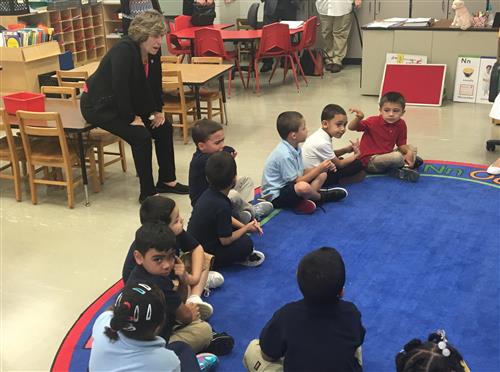Luis Munoz Marin moves away from 'zero-tolerance'

Students caught disrupting class or running through the halls won’t be yelled at or suspended, but they might be asked to participate in something called “running a circle.”
The “circles” are casual but strategic conversations among students and teachers that aim to reduce student misconduct by addressing the root cause of their misbehavior. It’s part of a strategy called restorative practices.
Ricardo Torres, principal at the dual-language school, is following the footsteps of school leaders across the nation who are abandoning the traditional, "zero-tolerance" behavior policy in favor of one that focuses on problem-solving and communication. The changes earned his school a visit Monday from Randi Weingarten, president of the American Federation of Teachers.
Just five weeks into the school year, Torres says he can already sense a change throughout the building. And he’s seen the benefits of restorative practices work before his eyes.
Torres recalled a recent incident with a seventh-grade girl who was having emotional issues and was dressing “goth,” which she said caused her grandmother to be mean to her. So the class “ran a circle,” where classmates offered different ways she could approach her problems at home.
The student took those suggestions home and had great success. Her grandmother apologized to the girl and said she wasn’t aware of her emotional problems. These de-escalation tactics are an example of a “problem-solving circle,” which Torres says are a tool to prevent students’ emotions from manifesting in bad behavior throughout the school day.
“How are we going to expect her to go in there and do seventh-grade math when she’s worried about this other thing?” Torres said. “We were able to address it first thing in the morning.”
Luis Muñoz Marin was one of the District’s low-performing "Investment Schools" assigned a corrective action plan when The Cleveland Plan went into effect in 2012. The plan called for changes to the school’s behavior policy and set goals to reduce suspensions and office referrals.
These are some of the challenges Torres hopes to tackle through restorative practices, along with his goals to increase attendance and boost academic success. Torres says traditional discipline like suspensions and detentions only hinder efforts to move the academic needle of the school.
“We need our kids in school and in class, not out in the street or out in the planning center (a constructive alternative to traditional in-school suspension),” he said. “We need them in front of certified teachers so they can learn.”
To learn how to implement the method in the classroom, school administrators spent four days last summer training with the International Institute for Restorative Justice in Bethlehem, Pa. The IIRP trainers also spent two days with every teacher to train them on the fundamentals. The training was paid for through a fund for "Investment Schools" under The Cleveland Plan.
Every classroom now starts the day with a “morning circle” to share concerns and discuss problems at school or at home. Torres said some younger students were reluctant and uncomfortable at first because they weren’t used to adults asking them how they feel. But that subsided over time, and teachers began to notice students using restorative practices language like “making norms” and “coming to agreement” in everyday conversations.
Luis Muñoz Marin’s new behavior policy was in the spotlight Monday when Weingarten (pictured above with a kindergarten class), visited. She met with teachers, administrators and students and said the school was on the right track with restorative practices.
“To give kids a responsibility about their own actions is incredibly vital for them to be able to live successfully in the world," Weingarten said. “The teacher training and student training are absolutely essential to this, and the fact that this school actually acknowledged that and understood that before they tried doing this was really important."
In schools that have already tried restorative practices, the data is promising. Studies from IIRP, the institution that trained Luiz Muñoz Marin teachers, show significant improvements at schools that implemented the strategy.
An elementary school in Baltimore that introduced restorative practices saw suspensions decrease 61 percent, the study found. The school saw office referrals drop 91 percent in that time frame.
IIRP studies also found that restorative practices helped narrow the racial discipline gap in many schools where minority students were more likely to be disciplined than white students.
For Luis Muñoz Marin eighth-grade teacher Ro Rossero, the new policy is about prioritizing students’ well-being and giving them a voice.
“These are basic human needs that we need to address, and if kids for whatever reason are not getting them met at home and parents are struggling with that, then someone has to do that,” Rossero said. “We have to step up and do that.”

